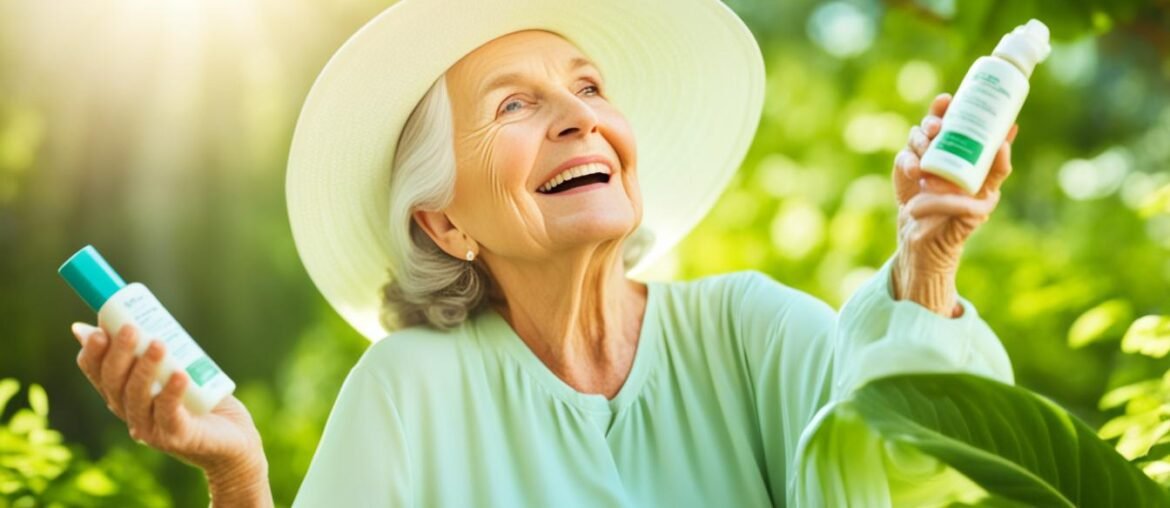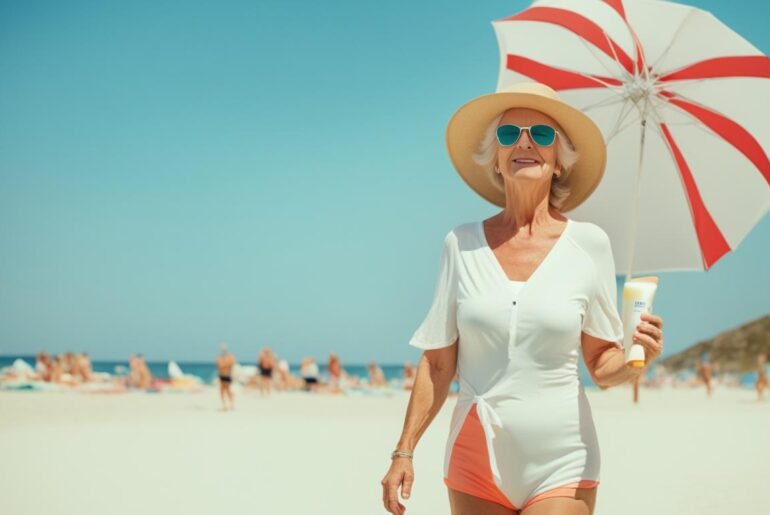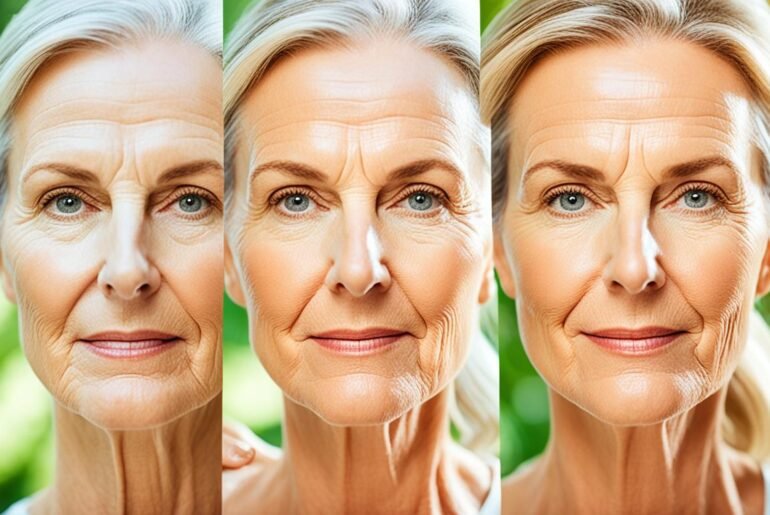Did you know that photoaging, the premature aging of the skin caused by ongoing exposure to UV radiation, is entirely preventable through sun protection?
Many people mistakenly believe that the appearance of aging skin is solely due to the natural aging process. However, the truth is that the sun’s harmful UV rays play a significant role in accelerating skin aging.
Whether you’re someone with fair skin or a darker complexion, protecting your skin from the sun is essential to maintain its health and youthful appearance. In this article, I will share expert tips and best practices that can help you shield your aging skin from sun damage and prevent the development of common sun-related issues, such as wrinkles, sagging skin, age spots, and even skin cancer.
Key Takeaways:
- Photoaging is preventable through sun protection measures, while chronological skin aging is a natural process.
- Individuals with a light skin tone, a history of skin cancer, or certain health conditions are at higher risk of sun-damaged skin.
- People of color can still experience sun-damaged skin and should take precautions.
- Certain health conditions and medications can increase the risk of sun-damaged skin.
- Effective sun protection strategies include using sunscreen, seeking shade, wearing protective clothing, and using sunglasses.
What is Photoaging and its Difference from Chronological Skin Aging?
Photoaging, a result of long-term exposure to UVA and UVB radiation, is the premature aging of the skin. Unlike chronological skin aging, which naturally occurs with age and genetics, photoaging is preventable through sun protection measures. UV radiation exposure can lead to DNA changes in skin cells, increasing the risk of developing skin cancer. While the DNA damage cannot be reversed, there are various treatments and skincare practices that can improve the appearance and quality of sun-damaged skin.
To grasp the concept of photoaging, it is important to understand the distinction between photoaging and chronological skin aging. Chronological skin aging refers to the natural process of aging that occurs over time due to genetic factors and internal mechanisms. It is an inevitable part of life that affects everyone.
On the other hand, photoaging is caused by external factors, primarily prolonged exposure to UV radiation from the sun and artificial sources, such as tanning beds. The harmful UVA and UVB rays can penetrate the skin, damaging the underlying structures and leading to premature aging.
“Photoaging is different from chronological skin aging because it can be prevented through sun protection measures.”
One of the key factors that differentiates photoaging from chronological skin aging is its preventability. While chronological skin aging cannot be stopped, photoaging can be significantly reduced or even prevented through proper sun protection.
It is crucial to understand the detrimental effects of UV radiation exposure on the skin. When the skin is exposed to UV rays, it triggers a series of reactions that can ultimately lead to DNA changes in the skin cells. These DNA changes can result in the development of skin cancer, further highlighting the importance of sun protection.
Although the DNA damage caused by UV radiation cannot be reversed, there are various treatments and skincare practices available that can improve the appearance and quality of sun-damaged skin. These may include topical treatments, peels, laser therapies, and other dermatological interventions.
Overall, while chronological skin aging is a natural process that cannot be prevented, photoaging is preventable through sun protection measures. By understanding the difference between these two types of skin aging and adopting a proactive approach to sun safety, individuals can minimize the harmful effects of UV radiation and maintain healthier and more youthful-looking skin.
Sun-Damaged Skin: A Visual Comparison
| Characteristic | Photoaging | Chronological Skin Aging |
|---|---|---|
| Causes | Long-term exposure to UV radiation | Natural aging process influenced by genetics and internal mechanisms |
| Preventable | Yes | No |
| DNA Changes | Increased risk of DNA damage and skin cancer | N/A |
| Appearance | Visible signs of premature aging, such as fine lines, wrinkles, age spots, and rough texture | Natural changes associated with aging, including fine lines, wrinkles, and loss of elasticity |
Who is at Risk for Sun-Damaged Skin?
Everyone is susceptible to sun-damaged skin, but certain factors increase the risk. People with a light skin tone, a history of skin cancer, numerous moles, freckles, blue or green eyes, and blond, red, or light brown hair have a higher risk. Additionally, individuals who live or vacation at high altitudes, spend a lot of time outdoors or at tanning salons, and had intense sun exposure during childhood are more prone to sun damage. It is important for people at higher risk to take extra precautions and protect their skin from the sun.
Sun Protection for People of Color

People of color, like individuals with lighter skin tones, are exposed to UV radiation that can lead to sun-damaged skin. Although they are less likely to experience sunburn, it is crucial for people of color to take sun protection measures to maintain skin health and reduce the risk of long-term damage.
Melanin, the brown pigment in the skin, offers some level of natural protection against harmful UV rays. However, it is important to note that individuals with darker skin can still develop damaged skin or sunburn, which can cause discomfort, pain, and peeling.
While there seems to be no direct relationship between sun exposure and skin cancer in dark-skinned individuals, it is worth noting that skin cancer can still occur. In people of color, skin cancer often manifests on the palms of the hands or soles of the feet and is frequently diagnosed at a later stage.
It’s essential for individuals of all skin tones to prioritize sun protection and incorporate it into their daily routines, regardless of their natural levels of melanin. By following sun protection strategies, people of color can help minimize the risk of sun-damaged skin and maintain the overall health and appearance of their skin.
The Role of Melanin in Sun Protection
Melanin, the pigment responsible for the color of skin, hair, and eyes, serves as the body’s natural defense mechanism against UV radiation. It acts as a shield by absorbing and scattering UV rays, minimizing their penetration into the deeper layers of the skin.
While melanin provides some level of protection, it is important to remember that no skin type is completely immune to the damaging effects of the sun. Sun protection practices should be followed by individuals of all skin tones.
Importance of Sun Protection for People of Color
Even though people of color may have a lower risk of sunburn, sun-damaged skin can still occur. The long-term effects of UV radiation exposure can lead to premature aging, fine lines, wrinkles, dark spots, and an increased risk of skin cancer.
By adopting sun protection measures, such as wearing sunscreen, seeking shade, and wearing protective clothing, people of color can effectively mitigate these risks and maintain healthy skin.
Health Conditions and Sun-Damaged Skin
Certain health conditions and medications can increase the risk of sun-damaged skin. Autoimmune diseases, such as systemic lupus erythematosus, and conditions that weaken the immune system, including HIV, can make the skin more susceptible to sun damage. Organ transplant recipients and individuals taking medications that weaken the immune system, such as corticosteroids and certain cancer treatments, are also at higher risk. Additionally, some medications can make the skin more sensitive to sunlight, increasing the chances of sunburn and sun damage. It is important for individuals with these health conditions to take extra precautions when exposed to the sun.
Having autoimmune diseases or a weakened immune system can leave the skin vulnerable to sun damage. Autoimmune diseases, like systemic lupus erythematosus (SLE), cause the immune system to mistakenly attack normal healthy cells, leading to inflammation and damage. SLE can affect various parts of the body, including the skin, and individuals with this condition may develop a skin sensitivity to sunlight known as photosensitivity. Exposure to sunlight can trigger or worsen SLE symptoms, resulting in a rash or other skin manifestations. It is essential for individuals with SLE to protect their skin from the sun to minimize the risk of flare-ups and further damage.
Moreover, individuals who have undergone organ transplants are often prescribed immunosuppressive medications to prevent the body from rejecting the transplanted organ. These medications, such as corticosteroids and certain immunosuppressants, weaken the immune system, making the skin more susceptible to sun damage. Organ transplant recipients should take diligent measures to protect their skin from the harmful effects of the sun’s rays to mitigate the risk of skin damage and potential complications.
Examples of autoimmune diseases :
- Systemic lupus erythematosus (SLE)
- Rheumatoid arthritis
- Multiple sclerosis
- Sjögren’s syndrome
“Individuals with autoimmune diseases and those taking immunosuppressive medications should be extra cautious when it comes to sun exposure. The weakened immune system and medications can make the skin more vulnerable to sun damage, leading to potential complications and exacerbation of symptoms.”
It is also worth noting that certain medications can make the skin more sensitive to sunlight, increasing the risk of sunburn and sun damage. Examples of such medications include specific antibiotics, nonsteroidal anti-inflammatory drugs (NSAIDs), diuretics, and certain acne medications. These medications can either increase the skin’s sensitivity to UV radiation or cause a phototoxic reaction when exposed to the sun. Individuals taking these medications should consult their healthcare provider or pharmacist about the potential side effects and take necessary precautions, such as using sunscreen and wearing protective clothing, to minimize the risk of sun damage.
Patients with autoimmune diseases, weakened immune systems, or those taking certain medications should prioritize sun protection to safeguard their skin. Here are some sun protection strategies to consider:
- Wearing protective clothing, such as long sleeves, long pants, and wide-brimmed hats, to shield the skin from direct sun exposure.
- Applying broad-spectrum sunscreen with a high sun protection factor (SPF) to all exposed areas of the skin.
- Seeking shade, especially during peak sun hours (typically between 10 a.m. and 4 p.m.) when the sun’s rays are strongest.
- Using sunglasses that offer UV protection to shield the eyes and surrounding delicate skin from harmful UV radiation.
Common Medications That Can Increase Sun Sensitivity
| Medication | Common Uses |
|---|---|
| Tetracycline | Bacterial infections |
| Nonsteroidal anti-inflammatory drugs (NSAIDs) | Pain relief, inflammation |
| Diuretics | High blood pressure, fluid retention |
| Retinoids | Acne, skin rejuvenation |
By understanding the potential risks and taking appropriate precautions, individuals with autoimmune diseases, weakened immune systems, organ transplant recipients, and those taking medications can effectively protect their skin from the damaging effects of the sun. Consistent sun protection practices, along with regular consultation with healthcare providers, can help minimize the risk of sun-damaged skin and promote overall skin health.
Essential Sun Protection Strategies
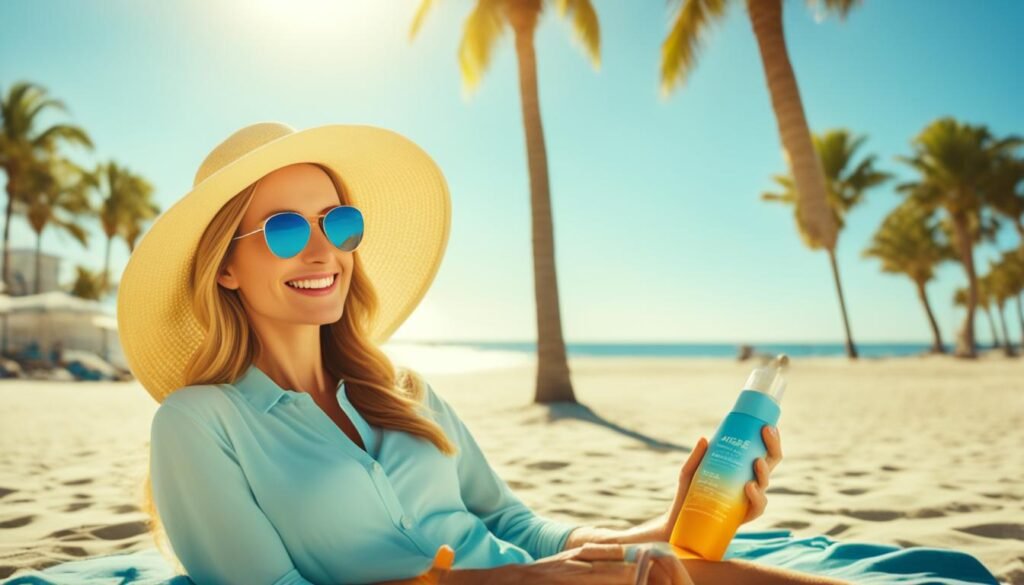
When it comes to protecting aging skin from the sun, implementing essential sun protection strategies is crucial. By following these recommendations, you can significantly reduce the risk of sun damage and premature aging.
1. Use Broad-Spectrum Sunscreen
Always apply a broad-spectrum sunscreen with at least SPF 15, regardless of the weather conditions. This will protect your skin from both UVA and UVB rays, which can cause long-term damage.
“Using sunscreen is crucial for protecting aging skin from the sun.”
Remember to apply sunscreen to all exposed areas of your skin, including your face, neck, arms, and hands. Don’t forget commonly overlooked areas such as the ears and the back of the neck. To ensure effectiveness, reapply sunscreen every two hours, after swimming, sweating, or toweling off.
2. Seek Shade
When spending time outdoors, seek shade to minimize direct sun exposure. This can include sitting under an umbrella, tree, or any other form of shelter that provides protection from harmful rays.
Wearing protective clothing is another effective sun protection strategy. Opt for long-sleeved shirts, long pants, and wide-brimmed hats to shield your skin from the sun’s rays. These clothing items act as a barrier and reduce direct exposure.
“Seeking shade, wearing protective clothing, and using wide-brimmed hats are effective sun protection strategies for aging skin.”
3. Wear Sunglasses
Your eyes are also vulnerable to sun damage. To protect them, wear sunglasses that block both UVA and UVB rays. Look for sunglasses with a high level of UV protection labeled on the lenses.
By implementing these sun protection strategies, you can safeguard your aging skin from harmful UV radiation, reducing the risk of sun damage, premature aging, and potential skin cancer.
Sun Protection Timing and Practices
Sun protection is crucial for maintaining healthy and youthful-looking skin. It’s important to practice sun protection throughout the year, not just during the summer months. Even on cool or cloudy days, UV rays can still reach your skin and cause damage. Additionally, UV rays can reflect off surfaces like water, snow, and cement, increasing your exposure to harmful radiation.
To effectively protect your skin, it is recommended to avoid outdoor activities during the peak sun hours, typically between 10 a.m. and 4 p.m. This is when the sun’s rays are the strongest and pose the highest risk of sun damage. Seek shade under an umbrella, tree, or other shelter during these hours to minimize your exposure. However, it’s important to note that even when in the shade, protective measures like sunscreen and clothing should still be utilized to ensure complete protection.
It’s essential to be mindful of the UV index, which indicates the intensity of UV radiation in your area. The UV index ranges from 1 (low) to 11+ (extremely high). Check your local weather forecast or use a reliable app to stay updated on the UV index. When the UV index is high, take extra precautions and consider reducing your time spent outdoors. Be sure to adjust your sun protection practices accordingly to protect your skin.
When it comes to clothing choices, opt for lightweight, loose-fitting garments that cover as much skin as possible. Wear long-sleeved shirts, long pants, and wide-brimmed hats to provide additional coverage and shade for your face, neck, and ears. Sunglasses that block both UVA and UVB rays are also important to protect your eyes and the delicate skin around them from sun damage.
Remember, the sun’s harmful rays can penetrate clouds, so don’t underestimate the power of sun protection on overcast days. By following these sun protection timing and practices, you can minimize your risk of sun damage and keep your skin healthy and protected all year round.
Choosing the Right Sun Protective Clothing
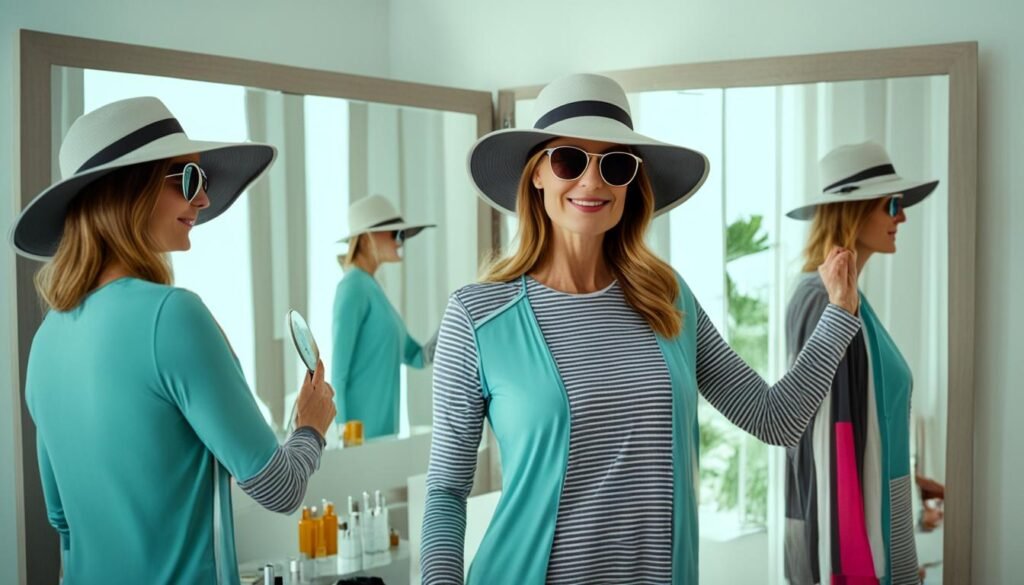
Clothing plays a crucial role in shielding your skin from the harmful effects of the sun’s UV rays. By carefully selecting the right attire, you can enhance your sun protection and minimize the risk of sun-damaged skin. Here are some key factors to consider when choosing sun protective clothing:
1. Long-Sleeved Shirts and Pants
Opt for clothing that covers as much of your skin as possible, such as long-sleeved shirts and long pants. These garments provide excellent physical protection against UV rays, reducing direct exposure to the sun.
2. Tightly Woven Fabric
Choose clothing made from tightly woven fabric, as it creates an effective barrier against UV radiation. Dense fabrics prevent the penetration of harmful rays, offering enhanced protection for your skin.
3. Wet vs. Dry Clothing
It’s important to note that wet clothing provides less UV protection than dry clothing. When enjoying water activities or sweating, ensure your garments are dry or have ultraviolet protection incorporated into their design.
4. Darker Colors
Darker-colored clothing generally offers more sun protection than lighter colors. Dark hues absorb and block a greater amount of UV radiation, reducing exposure to your skin.
5. UV-Certified Clothing
Consider UV-certified clothing, which is specifically designed to provide maximum protection against UV rays. This type of clothing undergoes testing to ensure it meets the designated UV protection standards. Look for garments with a UPF (Ultraviolet Protection Factor) rating to indicate their level of sun protection.
By incorporating these sun protective clothing choices into your wardrobe, you can significantly reduce your risk of sun-damaged skin and enjoy safer outdoor activities.
| Factors to Consider | Benefits |
|---|---|
| Long-Sleeved Shirts and Pants | Offers maximum skin coverage |
| Tightly Woven Fabric | Creates a strong barrier against UV rays |
| Wet vs. Dry Clothing | Dry clothing provides better sun protection |
| Darker Colors | Provides increased UV radiation absorption |
| UV-Certified Clothing | Ensures verified sun protection |
Conclusion
Protecting aging skin from the sun is essential to minimize the risk of sun-damaged skin, premature aging, and skin cancer. Implementing effective sun protection practices can help safeguard the health and appearance of your skin. By diligently following these strategies, you can prevent sunburn and reduce the harmful effects of UV rays.
One of the key sun protection practices is using sunscreen regularly. Apply a broad-spectrum sunscreen with at least SPF 15 to all exposed areas of your skin, even on cool or cloudy days. Remember to reapply every two hours or after swimming, sweating, or towel drying.
Additionally, seek shade especially during peak sun hours from 10 a.m. to 4 p.m. If you’re outdoors, choose protective clothing such as long-sleeved shirts, pants, and hats with wide brims. Consider wearing sunglasses that block both UVA and UVB rays to protect your eyes from harmful sunlight.
Consistency is crucial when it comes to sun protection. Make it a habit to incorporate these practices into your daily routine throughout the year, not just during the summer months. By prioritizing the prevention of sunburn and sun damage, you can help maintain the health and vitality of your aging skin.
FAQ
How can I protect aging skin from the sun?
To protect aging skin from the sun, it is important to use sunscreen with at least SPF 15, seek shade, wear protective clothing, and use sunglasses. These measures help reduce the risk of sun-damaged skin, premature aging, and skin cancer.
What is the difference between photoaging and chronological skin aging?
Photoaging is the premature aging of the skin caused by long-term exposure to UV radiation. It is preventable through sun protection measures. Chronological skin aging occurs naturally with age and genetics and is not preventable.
Who is at higher risk for sun-damaged skin?
People with a light skin tone, a history of skin cancer, numerous moles, freckles, blue or green eyes, and blond, red, or light brown hair are at higher risk. Additionally, individuals who live or vacation at high altitudes, spend a lot of time outdoors, had intense sun exposure during childhood, or use tanning salons are more prone to sun damage.
Can people of color experience sun-damaged skin?
Yes, people of color can experience sun-damaged skin. While they are less likely to get sunburned, sun damage can still occur. Melanin in darker skin tones offers some protection against UV rays, but it is still important to take sun protection measures to avoid skin damage.
Can certain health conditions and medications increase the risk of sun-damaged skin?
Yes, certain health conditions such as autoimmune diseases and a weakened immune system, as well as medications that make the skin more sensitive to sunlight, can increase the risk of sun-damaged skin. It is important for individuals with these conditions to take extra precautions when exposed to the sun.
What are some essential sun protection strategies for aging skin?
Essential sun protection strategies for aging skin include using broad-spectrum sunscreen with at least SPF 15, seeking shade, wearing protective clothing such as long-sleeved shirts and pants, using a hat with a wide brim, and wearing sunglasses that block both UVA and UVB rays.
Should sun protection be practiced only during the summer?
No, sun protection should be practiced throughout the year. UV rays can reach the skin on cool or cloudy days and can reflect off surfaces like water, snow, and cement. It is advisable to avoid outdoor activities between 10 a.m. to 4 p.m., when the sun’s rays are strongest, and to seek shade whenever possible.
How does clothing play a role in protecting the skin from the sun?
Clothing plays an important role in protecting the skin from the sun. Long-sleeved shirts, long pants, and skirts made from tightly woven fabric offer the best protection against UV rays. Darker colors generally provide more protection than lighter colors. Additionally, there are clothing items certified to offer UV protection, which can be considered for enhanced sun protection.
What is the importance of protecting aging skin from the sun?
Protecting aging skin from the sun is crucial for reducing the risk of sun-damaged skin, premature aging, and skin cancer. By following effective sun protection strategies, individuals can safeguard their skin from harmful UV rays and maintain its health and appearance.

